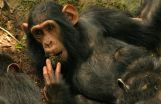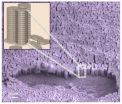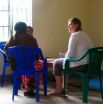(Press-News.org) Although we now appreciate that birds evolved from a branch of the dinosaur family tree, a crucial adaptation for flight has continued to puzzle evolutionary biologists. During the millions of years that elapsed, wrists went from straight to bent and hyperflexible, allowing birds to fold their wings neatly against their bodies when not flying.
How this happened has been the subject of much debate, with substantial disagreement between developmental biologists, who study how the wings of modern birds develop in the growing embryo, and palaeontologists who study the bones of dinosaurs and early birds. A resolution to this impasse is now provided by an exciting new study publishing on September 30 in PLOS Biology.
Underlying this striking evolutionary transformation change is a halving in the number of wrist bones, but developmental biologists and palaeontologists have different names for most of them, and seldom agree on the correspondence between specific dinosaur bones and those of their bird descendants. Indeed, each field has radically different data sources, methods, and research objectives, talking little to each other.
The critical advance made in the new study involved combining these two strands of research. Using an interdisciplinary approach, the lab run by Alexander Vargas at the University of Chile has re-examined fossils stored at several museum collections, while at the same time collecting new developmental data from seven different species of modern birds. Joao Botelho, a Brazilian student in Vargas' lab, developed a revolutionary new technique that allows him to study specific proteins in 3D embryonic skeletons. By combining these data from both fossils and embryos, the research team has made a major step forward in clarifying how the bird wrist evolved.
From early dinosaur ancestors with as many as nine wrist bones, birds have only kept four during the course of evolution, but which of the original bones are they? The identity of each of these bones was debated. For instance, the late Yale professor John Ostrom famously pointed out in the 1970's that the wrists of both birds and bird-like dinosaurs possess a very similar, half-moon shaped bone called the semilunate, and that this bone resulted from the merging of two bones present in dinosaurs. This formed part of Ostrom's then-controversial argument that birds descended from dinosaurs. However, the failure of developmental biologists to confirm this raised doubts that it was the same bone, and even that birds came from dinosaurs.
Now, the new data obtained by the Vargas lab has revealed the first developmental evidence that the bird semilunate was formed by the fusion of the two dinosaur bones. They go on to show that another bone – the pisiform – was lost in bird-like dinosaurs, but then re-acquired in the early evolution of birds, probably as an adaptation for flight, where it allows transmission of force on the downstroke while restricting flexibility on the upstroke. Combined, the fossil and developmental data provide a compelling scenario for a rare case of evolutionary reversal.
The study by the Vargas lab also settled the identity of the other two bones of the bird wrist, which were commonly misidentified in both fields. This emphasizes the downsides of not integrating all data sources, and reveals a situation perhaps akin to that of astronomy and experimental physics in the pursuit of cosmology: Together, palaeontology and development can come much closer to telling the whole story of evolution – this integrative approach resolves previous disparities that have challenged the support for the dinosaur-bird link and reveals previously undetected processes, including loss of bones, fusion of bones, and re-evolution of a transiently lost bone.
INFORMATION:
Please mention PLOS Biology as the source for this article and include the links below in your coverage to take readers to the online, open access articles
All works published in PLOS Biology are open access, which means that everything is immediately and freely available. Use this URL in your coverage to provide readers access to the paper upon publication:
http://www.plosbiology.org/article/info:doi/10.1371/journal.pbio.1001957
Contact:
Alexander O. Vargas
Email: alexvargas@uchile.cl
Citation: Botelho JF, Ossa-Fuentes L, Soto-Acuña S, Smith-Paredes D, Nuñez-León D, et al. (2014) New Developmental Evidence Clarifies the Evolution of Wrist Bones in the Dinosaur–Bird Transition. PLoS Biol 12(9): e1001957. doi:10.1371/journal.pbio.1001957
Funding: Funding was provided by Fondo de Desarrollo Cient ífico y Tecnológico (Government of Chile: http://www.conicyt.cl/fondecyt/) Regular Grant 1120424 to AOV. SS-A, LO-F, DN-L, and JFB were supported by graduate school scholarships from the Programa de Formación de Capital Humano Avanzado, Comisión Nacional de Investigación Cient ífica y Tecnológica (Government of Chile, http://www.conicyt.cl/becas-conicyt/). The funders had no role in study design, data collection and analysis, decision to publish, or preparation of the manuscript.
Competing Interests: The authors have declared that no competing interests exist
How dinosaur arms turned into bird wings
2014-09-30
ELSE PRESS RELEASES FROM THIS DATE:
Study shows how chimpanzees share skills
2014-09-30
Evidence of new behaviour being adopted and transmitted socially from one individual to another within a wild chimpanzee community is publishing on September 30 in the open access journal PLOS Biology. This is the first instance of social learning recorded in the wild.
Scientists from University of St Andrews, University of Neuchâtel, Anglia Ruskin University, and Université du Quebec studied the spread of two novel tool-use behaviours among the Sonso chimpanzee community living in Uganda's Budongo Forest. Dr Catherine Hobaiter, Lecturer in Psychology at the University ...
Boys and girls who've had a traumatic brain injury differ in rates of harmful behavior
2014-09-30
TORONTO, Sept. 30, 2014 – Teenagers who said they had a traumatic brain injury in their lifetime, especially girls, also reported significantly higher rates of harmful behavior, according to new research.
The study looked at 13 harmful health behaviours –such as contemplating suicide, smoking marijuana or binge drinking– among 9,288 Ontario students between Grades 7 and 12.
"Both boys and girls were more likely to engage in a variety of harmful behaviours if they reported a history of TBI, but girls engaged in all 13 harmful behaviours we looked for, whereas boys were ...
Blades of grass inspire advance in organic solar cells
2014-09-30
AMHERST, Mass. – Using a bio-mimicking analog of one of nature's most efficient light-harvesting structures, blades of grass, an international research team led by Alejandro Briseno of the University of Massachusetts Amherst has taken a major step in developing long-sought polymer architecture to boost power-conversion efficiency of light to electricity for use in electronic devices.
Briseno, with colleagues and graduate students at UMass Amherst and others at Stanford University and Dresden University of Technology, Germany, report in the current issue of Nano Letters ...
Comprehensive Study of allergic deaths in US finds medications are main culprit
2014-09-30
September 30, 2014—(BRONX, NY)—Medications are the leading cause of allergy-related sudden deaths in the U.S., according to an analysis of death certificates from 1999 to 2010, conducted by researchers at Montefiore Medical Center and Albert Einstein College of Medicine of Yeshiva University. The study, published online today in the Journal of Allergy and Clinical Immunology, also found that the risk of fatal drug-induced allergic reactions was particularly high among older people and African-Americans and that such deaths increased significantly in the U.S. in recent ...
The cultural side of science communication
2014-09-30
EVANSTON, Ill. --- Do we think of nature as something that we enjoy when we visit a national park and something we need to "preserve?" Or do we think of ourselves as a part of nature? A bird's nest is a part of nature, but what about a house?
The answers to these questions reflect different cultural orientations. They are also reflected in our actions, our speech and in cultural artifacts.
A new Northwestern University study, in partnership with the University of Washington, the American Indian Center of Chicago and the Menominee tribe of Wisconsin, focuses on science ...
Rating the planet's oceans
2014-09-30
The most comprehensive assessment conducted by the Ocean Health Index rates the Earth's oceans at 67 out of 100 in overall health. In addition, for the first time, the report assessed the Antarctic and the 15 ocean regions beyond national jurisdiction (high-seas areas) — all critical regions for maintaining a healthy climate, safeguarding biodiversity and providing sustainable food sources.
In the third annual update of the index, a partnership led by scientists from UC Santa Barbara's National Center for Ecological Analysis and Synthesis (NCEAS) and Conservation International ...
New diagnostic approach for autism in Tanzania
2014-09-30
PROVIDENCE, R.I. [Brown University] — Autism is no stranger to the children of Tanzania. What is rare in the East African nation is access to clinical services, including reliable diagnosis and evidence-based treatments. There is no autism diagnostic measure, for example, validated for use in Swahili, a major language of the region. In a small new study, however, researchers at Brown University and the University of Georgia (UGA) describe a culturally compatible diagnostic approach that they implemented at two sites in the country and found to be effective for making diagnoses.
The ...
This week from AGU: Measuring Antarctic ice loss, Indian Ocean program, Oregon landslides
2014-09-30
This week from AGU: Measuring Antarctic ice loss, Indian Ocean program, Oregon landslides
From AGU's blogs: Scientists use fiber-optic cables to measure ice loss in Antarctic
Researchers installed moorings containing fiber-optic cables hundreds of meters down into the McMurdo Ice Shelf in West Antarctica to collect temperature information about the base of the ice shelf, where the thick platform of floating ice meets the ocean. The sensors were able to measure mere millimeters of ice loss at the interface, demonstrating that the new fiber-optic method could be ...
Depression increasing across the country
2014-09-30
SAN DIEGO, Calif. (Sept. 30, 2014)— A study by San Diego State University psychology professor Jean M. Twenge shows Americans are more depressed now than they have been in decades.
Analyzing data from 6.9 million adolescents and adults from all over the country, Twenge found that Americans now report more psychosomatic symptoms of depression, such as trouble sleeping and trouble concentrating, than their counterparts in the 1980s.
"Previous studies found that more people have been treated for depression in recent years, but that could be due to more awareness and less ...
Disease decoded: Gene mutation may lead to development of new cancer drugs
2014-09-30
ANN ARBOR—The discovery of a gene mutation that causes a rare premature aging disease could lead to the development of drugs that block the rapid, unstoppable cell division that makes cancer so deadly.
Scientists at the University of Michigan and the U-M Health System recently discovered a protein mutation that causes the devastating disease dyskeratosis congenita, in which precious hematopoietic stem cells can't regenerate and make new blood. People with DC age prematurely and are prone to cancer and bone marrow failure.
But the study findings reach far beyond the ...




